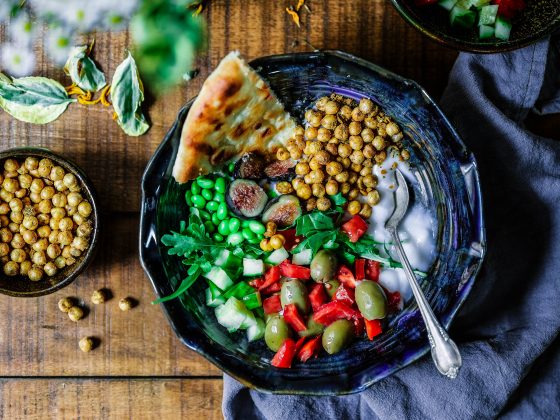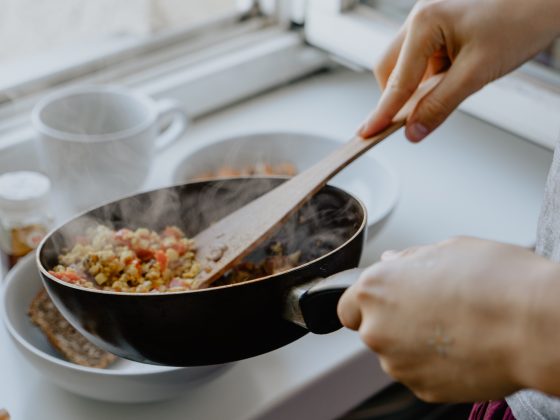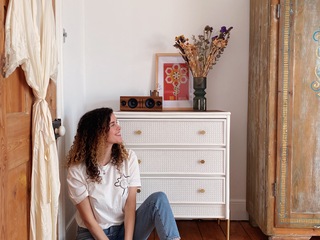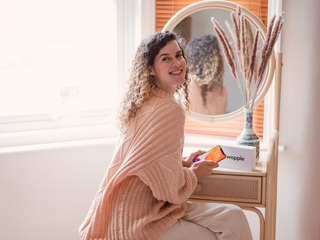
{Deutsche Version hier}
What to buy in the supermarket when first becoming vegan can be one of the biggest struggles. But don’t worry, for Veganuary I’ve created a detailed list with all the staples that you need in your vegan kitchen.
I have been vegan for nearly 9 years now, so I can only give my personal tips on how to do it in the supermarket. You need to know that I try to eat as much whole foods as possible. I don’t forbid myself from eating anything, eat packaged or processed products, white bread and normal sugar as well, but in moderation and I try to cook at home using only whole foods.
The vegan staples list (I do not buy everything at once from the list below, but usually have 1-2 products from every category at home):
- Vegetables:
- I try to bring in as much variety as possible during the week to cover all the nutrients and vitamins that I need! That’s why I do not have an exact list, but I buy a mix of:
- Green vegetables such as lettuce, spinach (mostly frozen), kale (mostly frozen), zucchini, etc.
- Paprika (high vitamin C content)
- Cruciferous vegetables such as broccoli, Brussels sprouts, cauliflower, cabbage etc.
- And of course standards like potatoes, onions and garlic, ginger
- Etc.
- Fruit:
- Here I try to buy whats in season, but mostly I always have:
- bananas
- apples
- Blueberries (mostly frozen)
- Lemons
- Pasta & other cereals / carbohydrates:
- I try to buy wholewheat whenever I can e.g. wholewheat pasta
- Rice and brown rice
- Wholewheat, some may not like this, so other whole grains are also an option, e.g. Greens, wholemeal wheat, buckwheat, millet, etc.
- Breakfast cereals:
- Oats (great whole grain products!)
- Crunchy granola
- Muesli
- Amaranth
- Etc.
- Nuts & seeds (I snack on them, add them to smoothies, or make sauces or pesto):
- cashews
- walnuts
- hemp seeds
- pumpkin seeds
- Sunflower seeds (pretty cheap)
- Flaxseed (cheap and I always have it at home and eat it every day!)
- Hemp seds
- Sesame seeds
- almond butter, peanut butter, tahini and cashew butter in a jar (without salt or other additives, relatively expensive!)
- Etc.
- Canned goods:
- Of course, you can also buy these dry and cook them yourself, but for beginners or if you need to whip something up fast canned products are the easiest
- beans
- Chickpeas
- canned tomatoes
- coconut milk (I buy coconut puree in a glass jar and just mix it right into the dishes or with warm water)
- Etc.
- Other protein sources:
- Green peas – I usually buy them frozen and then use them spontaneously, for example I often just add them to sauces
- Tempeh – I LOVE tempeh and swear on it! I usually buy turmeric tempeh from the company Tempehmanufaktur (unpaid advertising, haha)
- Tofu: here you just have to try out different types for yourself, I often buy natural, organic and from Europe, and marinate it myself, but as a beginner I recommend one of the flavored Taifun tofus – these are the best (unpaid advertising)
- Lentils, I like to buy red lentils, they cook the fastest
- Seitan – I love it, if you buy seitan flour you can make your own seitan for very little money
- Then my personal preference, but not a must: soy granules (eg for Bolognese)
- Spices, vinegar, oils and similar:
- Nutritional yeast – a MUST for the vegan kitchen 🙂 But not all brands taste good. I like the nutritional yeast from Dr. Ritter, which can be found in the health food store, as well as the nutritional yeast by Naturata
- turmeric
- Cayenne pepper
- Holy Veggie spice by Sonnentor (advertising without commission, I just love)
- Miso paste
- Tamari
- Kala namak salt (great for an “eggy” aroma)
- vegetable stock
- balsamic vinegar
- mustard
- And of course spices that you like, basil, oregano, etc.
- I cook mostly without oil, I just use some water, and usually bake without oil, e.g. oven potatoes, which is why I don’t have many tips for delicious oils or vegan butter
- Vegan Milk Alternatives:
- Here you have to honestly try out what you like the most, here are my favorites:
- Oatmilk, almost any, my absolute favorites are: Joya oatmilk unsweetened (in the Rewe), because it’s delicious, foams great and the price is ok for me, as well as Oatly Barista, with added vitamins, tastes really good and also foams very well (but it is quite expensive!!!)
- Soymilk – almost doesn’t really matter which brand, as long as it is organic
- sweeteners:
- I also have normal sugar at home, as I said, I’m not so dogmatic, but I try to use it as little as possible
- Maple syrup – great for baking and pancakes 🙂
- Dates – great for smoothies!
- rice syrup
- protein powder
- Only for gym rats, haha, not a must, but I’m often asked which protein powder I recommend, and the products of Vivo Life (unpaid advertising) are by far my favorite
- Supplements:
- In 30 days, you do not have to worry about it (if you’re sick or pregnant or any other special circumstances then talk to your doctor before you do this challenge), but if the question comes up: I supplement vitamin D and vitamin B12 regularly and also usually Omega 3
I often received feedback that the vegan diet is expensive. As I said, if you only buy replacement products, then yes. But since I was a student when I went vegan, I know that it can also be done on a smaller budget, even in smaller cities. Most of the products presented are very cheap and available almost everywhere. A few products, such as Kala Namak or nutritional yeast, can only be found in health food stores. But for these you buy them once and then they last for a very long time.
Here you can print the short version of the list:

A tip for the switch:
In my opinion, the switch can only be successful for a longer period of time if you don’t leave out specific food groups. Many who switch to a vegan diet simply leave out the animal products, then only eat side dishes and do not replace the animal proteins. It would be no wonder if you are unsatisfied with the food in this case and this can then also lead to nutrient deficiencies. And furthermore if you just leave out and don’t replace, you won’t get to know the very diverse and delicious vegan cuisine. So if you like to eat schnitzel, then try a soy schnitzel to start. These sorts of processed products are often frowned upon in the super healthy vegan circles, but they make the switch easier and delicious too 🙂 I love vegan chicken nuggets, for example. If you want to eat a balanced diet, you should, of course, not consider these replacement products as staple foods (in my opinion, that’s why they are not listed above), but they are tasty and practical (and often high in protein).
Healthy vs unhealthy
I don’t want to give any health recommendations or any health advice here. I am not a doctor or nutritionist and I find it frightening how many bloggers give health tips online, which tend to have orthorexic features and are rather negative triggers for many susceptible readers. Therefore: please do not stress about the topic “Healthy vs. Unhealthy”. Online veganism quickly drifts in the esoteric direction, in which one should eat very restrictively and “clean” based on innumerable fears about food.
I don’t think you have to completely exclude certain foods for health reasons (unless of course you’re allergic to them). My personal opinion is:
“All things are poison and nothing is without poison; it is only the dose that makes a thing not poison.” (Paracelsus quote)
That’s why I don’t say that you should only eat whole foods, no sugar, no gluten, etc. Balance is important and food should not be a subject that causes stress and the term clean eating is simply a thorn in my side. I only mention this because the vegan diet is often associated with clean eating and I personally want to distance myself from this. I feel healthy and maybe even better than before my vegan change, but my biggest motivator for the vegan diet are climate, environmental and animal protection reasons.
Nevertheless, it is helpful, especially when you switch to the vegan diet, to really inform yourself about what a balanced diet is. I find the Dr. Greger Daily Dozen checklist helpful. This consists of 12 points / foods that you should integrate into your daily menu as much as possible. The list personally helps me to add variety to my food and to think of new dishes. If I can’t think of anything to cook, I just think about what I’m missing on the Dr. Greger checklist and cook it. In the checklist you will find:
- All kinds of beans and lentils
- Berries
- More fruit
- Flax seed
- nuts
- spices
- cruciferous vegetables
- Green leafy vegetables
- More vegetables
- whole grain
- Drink enough
- Exercise, vitamin B12 and vitamin D.
I also find the Vegan Food Pyramid from Peta helpful. Similar to the Dr. Greger checklist, it is helpful as a guideline and when you can’t remember what to cook and eat. Generally I don’t forbid myself anything, sometimes I eat pizza, burgers and ice cream without a bad conscience and then again enjoy salad and fresh vegetables. I also believe that with this balance, relaxed and unrestrained view of the vegan diet, I am able to have a good relationship with food and have been eating vegan for almost 9 years now. I just wanted to put that out there because there is a lot of pseudo-science in the field of veganism and health, which has both positive and negative sides. See e.g. the topic of ex-vegans on YouTube, who mostly had health problems due to a very restrictive vegan diet and are now more on the anti-vegan side. I know I am generalizing here, but the topic is too big to fit into a blog article. There is a more detailed article on Fashionchangers. There I have already interviewed experts on this topic: “Are nutrition tips in social media dangerous?” (however, only in German).
Back to the main topic:
I hope that with the shopping list written above, you are ready for your first vegan supermarket excursion. As I said, you don’t have to buy everything at once, but tofu, nutritional yeast and beans are a great start. Have fun, just try veganizing your favorite dishes and feel free to leave me any questions in the comments! Check out my first Veganuary blogpost here!


 Deutsch
Deutsch










6 comments
Richtig cooler Artikel! 🙂
Hey! Mega schöner Blogpost! 🙂 Ich stimme dir auch vollkommen zu, bei dem was du kurz über “clean eating” geschrieben hast. Ich hätte noch einen Verbesserungsvorschlag, und zwar könntest du ja, anstatt immer “Werbung ohne Auftrag” zu schreiben, zwei Sternchen dahinter machen und das wie bei den Affiliate Links nur einmal nach unten schreiben. Das stört nämlich etwas beim Lesefluss. 🙂 Ganz liebe Grüße
Danke für den Artikel! Ich habe als Neujahrsvorsatz, ganz auf vegan umzusteigen, daher hilft dein Veganuary auf jeden Fall sehr! Mach weiter so 🙂
Hey,
ein richtig toller Artikel :).
Vegan einzukaufen ist wirklich alles andere als schwer.
LG
Ich lebe inwzischen auch seit 4 Jahren vegan, ich finde super, dass du das Thema den Menschen hier näher bringst. Die Klischee-Fragen: Ist das nicht teuer? Und was kannst du denn dann überhaupt noch essen? – dürften hiermit erledigt sein. 😉 Ich hätte da aber noch eine Frage: hast du keine Probleme mit deinem Eisengehalt? Mein Eisenhaushalt ist schon im Keller seit ich Teenager bin..aber als ich dann auch noch vegan wurde, ist er komplett abgestürzt. Inzwischen hab ich das ganz gut im Griff, weil ich mir einfach in meinen morgendlichen Saft immer Rote Beete Pulver von Vitaminexpress.org/Rote-beete-pulver untermische, das hat super viel Eisen. Aber da du kein Eisen supplementierst, wollte ich mal fragen, wie du das machst? Ich kann nicht jeden Tag weiße Bohnen essen, um das zu kompensieren.. 😀 Aber vielleicht hab ich auch einfach nur Pech und mein Körper kann Eisen nicht so gut aufnehmen. Weiß ja keiner, ob das nicht auch passiert wäre, wenn ich nicht vegan geworden wäre. Aber vielleicht hast du auch einen super Tipp für mich. 🙂
Liebe Grüße
Maja
It’s so hard living in a country with little to non vegan options. I have to make everything myself. It’s taking a lot out of me.